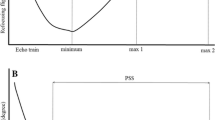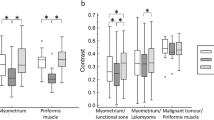Abstract
Objectives
To determine the clinical feasibility of T2-weighted turbo spin-echo (T2-TSE) imaging with deep learning reconstruction (DLR) in female pelvic MRI compared with conventional T2 TSE in terms of image quality and scan time.
Methods
Between May 2021 and September 2021, 52 women (mean age, 44 years ± 12) who underwent 3-T pelvic MRI with additional T2-TSE using a DLR algorithm were included in this single-center prospective study with patient’s informed consents. Conventional, DLR, and DLR T2-TSE images with reduced scan times were independently assessed and compared by four radiologists. The overall image quality, differentiation of anatomic details, lesion conspicuity, and artifacts were evaluated using a 5-point scale. Inter-observer agreement of the qualitative scores was compared and reader protocol preferences were then evaluated.
Results
In the qualitative analysis of all readers, fast DLR T2-TSE showed significantly better overall image quality, differentiation of anatomic regions, lesion conspicuity, and lesser artifacts than conventional T2-TSE and DLR T2-TSE, despite approximately 50% reduction in scan time (all p < 0.05). The inter-reader agreement for the qualitative analysis was moderate to good. All readers preferred DLR over conventional T2-TSE regardless of scan time and preferred fast DLR T2-TSE (57.7–78.8%), except for one who preferred DLR over fast DLR T2-TSE (53.8% vs. 46.1%).
Conclusion
In female pelvic MRI, image quality and accelerated image acquisition for T2-TSE can be significantly improved by using DLR compared to conventional T2-TSE. Fast DLR T2-TSE was non-inferior to DLR T2-TSE in terms of reader preference and image quality.
Clinical relevance statement
DLR of T2-TSE in female pelvic MRI enables fast imaging along with maintaining optimal image quality compared with parallel imaging-based conventional T2-TSE.
Key Points
• Conventional T2 turbo spin-echo based on parallel imaging has limitations for accelerated image acquisition while maintaining good image quality.
• Deep learning image reconstruction showed better image quality in both images obtained using the same or accelerated image acquisition parameters compared with conventional T2 turbo spin-echo in female pelvic MRI.
• Deep learning image reconstruction enables accelerated image acquisition while maintaining good image quality in the T2-TSE of female pelvic MRI.





Similar content being viewed by others
Abbreviations
- DLR:
-
Deep learning reconstruction
- GRAPPA:
-
Generalized autocalibrating partially parallel acquisition
- HASTE:
-
Half-Fourier-acquired single-shot turbo spin echo
- NEX:
-
Number of excitations
- SNR:
-
Signal-to-noise ratio
- T2-TSE:
-
T2-weighted turbo spin-echo
References
Thomassin-Naggara I, Poncelet E, Jalaguier-Coudray A et al (2020) Ovarian-Adnexal Reporting Data System Magnetic Resonance Imaging (O-RADS MRI) score for risk stratification of sonographically indeterminate adnexal masses. JAMA Netw Open 3:e1919896
Manganaro L, Lakhman Y, Bharwani N et al (2021) Staging, recurrence and follow-up of uterine cervical cancer using MRI: updated Guidelines of the European Society of Urogenital Radiology after revised FIGO staging 2018. Eur Radiol 31:7802–7816
Bazot M, Bharwani N, Huchon C et al (2017) European society of urogenital radiology (ESUR) guidelines: MR imaging of pelvic endometriosis. Eur Radiol 27:2765–2775
Deshmane A, Gulani V, Griswold MA, Seiberlich N (2012) Parallel MR imaging. J Magn Reson Imaging 36:55–72
Heidemann RM, Ozsarlak O, Parizel PM et al (2003) A brief review of parallel magnetic resonance imaging. Eur Radiol 13:2323–2337
Hammernik K, Klatzer T, Kobler E et al (2018) Learning a variational network for reconstruction of accelerated MRI data. Magn Reson Med 79:3055–3071
Yang G, Yu S, Dong H et al (2018) DAGAN: deep de-aliasing generative adversarial networks for fast compressed sensing MRI reconstruction. IEEE Trans Med Imaging 37:1310–1321
Gassenmaier S, Afat S, Nickel D, Mostapha M, Herrmann J, Othman AE (2021) Deep learning-accelerated T2-weighted imaging of the prostate: reduction of acquisition time and improvement of image quality. Eur J Radiol 137:109600
Gassenmaier S, Afat S, Nickel MD et al (2021) Accelerated T2-weighted TSE imaging of the prostate using deep learning image reconstruction: a prospective comparison with standard T2-weighted TSE imaging. Cancers (Basel) 13:3593
Ueda T, Ohno Y, Yamamoto K et al (2021) Compressed sensing and deep learning reconstruction for women’s pelvic MRI denoising: utility for improving image quality and examination time in routine clinical practice. Eur J Radiol 134:109430
Park JC, Park KJ, Park MY, Kim MH, Kim JK (2022) Fast T2-weighted imaging with deep learning-based reconstruction: evaluation of image quality and diagnostic performance in patients undergoing radical prostatectomy. J Magn Reson Imaging 55:1735–1744
Recht MP, Zbontar J, Sodickson DK et al (2020) Using deep learning to accelerate knee MRI at 3 T: results of an interchangeability study. AJR Am J Roentgenol 215:1421–1429
Isogawa K, Ida T, Shiodera T, Takeguchi T (2018) Deep shrinkage convolutional neural network for adaptive noise reduction. IEEE Signal Process Lett 25:224–228
Lebel RM (2020) Performance characterization of a novel deep learning-based MR image reconstruction pipeline. arXiv:2008.06559 [eess.IV]
Herrmann J, Nickel D, Mugler JP 3rd et al (2021) Development and evaluation of deep learning-accelerated single-breath-hold abdominal HASTE at 3 T using variable refocusing flip angles. Invest Radiol 56:645–652
Herrmann J, Gassenmaier S, Nickel D et al (2021) Diagnostic confidence and feasibility of a deep learning accelerated HASTE sequence of the abdomen in a single breath-hold. Invest Radiol 56:313–319
Kim EH, Choi MH, Lee YJ, Han D, Mostapha M, Nickel D (2021) Deep learning-accelerated T2-weighted imaging of the prostate: impact of further acceleration with lower spatial resolution on image quality. Eur J Radiol 145:110012
Youn SY, Choi MH, Kim DH et al (2021) Detection and PI-RADS classification of focal lesions in prostate MRI: performance comparison between a deep learning-based algorithm (DLA) and radiologists with various levels of experience. Eur J Radiol 142:109894
Johnson PM, Tong A, Donthireddy A et al (2022) Deep learning reconstruction enables highly accelerated biparametric MR imaging of the prostate. J Magn Reson Imaging 56:184–195
Uecker M, Lai P, Murphy MJ et al (2014) ESPIRiT–an eigenvalue approach to autocalibrating parallel MRI: where SENSE meets GRAPPA. Magn Reson Med 71:990–1001
Westphalen AC, Noworolski SM, Harisinghani M et al (2016) High-resolution 3-T endorectal prostate MRI: a multireader study of radiologist preference and perceived interpretive quality of 2D and 3D T2-weighted fast spin-echo MR images. AJR Am J Roentgenol 206:86–91
Svanholm H, Starklint H, Gundersen HJ, Fabricius J, Barlebo H, Olsen S (1989) Reproducibility of histomorphologic diagnoses with special reference to the kappa statistic. APMIS 97:689–698
Gassenmaier S, Küstner T, Nickel D et al (2021) Deep learning applications in magnetic resonance imaging: has the future become present? Diagnostics (Basel) 11:2181
Turkbey B, Rosenkrantz AB, Haider MA et al (2019) Prostate Imaging Reporting and Data System Version 2.1: 2019 Update of Prostate Imaging Reporting and Data System Version 2. Eur Urol 76:340–351
Acknowledgements
This research was supported by the Soonchunhyang University research fund.
Author information
Authors and Affiliations
Corresponding author
Ethics declarations
Guarantor
The scientific guarantor of this publication is Jiyoung Hwang.
Conflict of interest
Co-authors Jae Kon Sung and Dominik Nickel are employees of Siemens Healthineers or Siemens Healthcare. The other authors declare that they have no known competing financial interests or personal relationships that could have appeared to influence the work reported in this paper.
Statistics and biometry
The statistical methods and analysis in this study were reviewed and supervised by a medical statistician.
Informed consent
Written informed consents were obtained for all participants in this study.
Ethical approval
This prospective study was approved by the institutional review board (IRB 2021-03-017) and written informed consent for additional T2-weighted sequences using deep learning reconstruction was obtained from each individual.
Methodology
-
Prospective
-
Observational study
-
Performed at one institution
Additional information
Publisher's note
Springer Nature remains neutral with regard to jurisdictional claims in published maps and institutional affiliations.
Rights and permissions
Springer Nature or its licensor (e.g. a society or other partner) holds exclusive rights to this article under a publishing agreement with the author(s) or other rightsholder(s); author self-archiving of the accepted manuscript version of this article is solely governed by the terms of such publishing agreement and applicable law.
About this article
Cite this article
Lee, E.J., Hwang, J., Park, S. et al. Utility of accelerated T2-weighted turbo spin-echo imaging with deep learning reconstruction in female pelvic MRI: a multi-reader study. Eur Radiol 33, 7697–7706 (2023). https://doi.org/10.1007/s00330-023-09781-z
Received:
Revised:
Accepted:
Published:
Issue Date:
DOI: https://doi.org/10.1007/s00330-023-09781-z




